The Best Things To Do In The Badlands National Park
In this guide, you will find the best things to do and see in the Badlands National Park.
South Dakota is home to the Badlands. As you explore this area, you will see stunning rock formations, steep canyons, and towering spires that define its landscape, and prairie dogs, bison, and bighorn sheep live in the sprawling grasslands of the area.
Along Highway 240, you’ll find scenic lookouts along the Badlands Loop Road. In addition to many hiking trails that begin near the Ben Reifel Visitor Center, the boardwalk displays about fossils found in the park are displayed along the Fossil Exhibit Trail.
Table of Contents
Badlands National Park
It was still dark as I left Cedar Pass Campground around 3:30 AM and drove into Badlands National Park to see the sunrise from one of the overlooks in the park.
The Badlands are a vast expanse of grasslands dotted with wild animals and strange-looking jutting rock formations called pinnacles. It’s also a designated Dark-Sky area.
It was the perfect time of day to get started because my number one reason for coming to explore this time was to photograph the Milky Way over the crazy rock formations found here.
As my van rolled over the pre-dawn, very dark, deserted road, I felt my heart quicken with anticipation. I couldn’t see what was out there past the light from my van’s headlights and was a little nervous to hop out to make some photos.
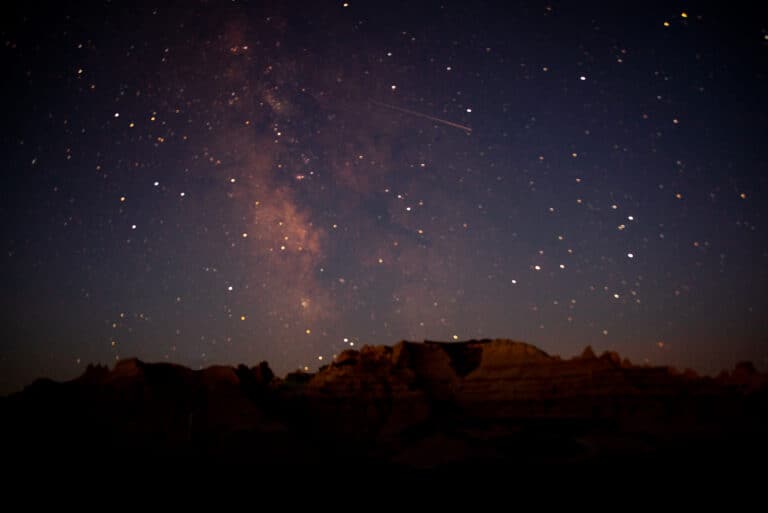
My skin prickled as the quietness of the night was occasionally punctuated by the distant echo of a nocturnal creature. Riding a photography high that pushes me to get those wildering shots, the dawn’s early light could be seen after an hour of shooting the dark night sky.
I quickly packed up my gear and headed west on the Badlands Loop Road that early morning, searching for the perfect place to capture the sunrise, the second reason I was in the park, hoping to make a sought-after hero shot photographers long for.
The valley to my left was filled with dense fog. The air was crisp, and the early morning sky turned a brilliant cornflower blue.
Starting the day with the breathtaking early morning views in the Badlands National Park filled me with peace and contentment. It was a perfect beginning to this trip.
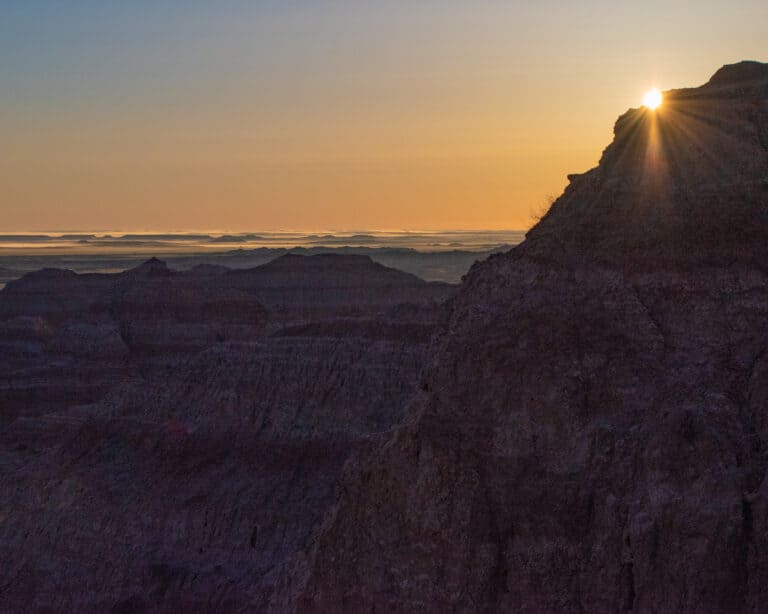
Exploring The Badlands
Exploring Badlands National Park is a great way to begin a road trip from Sioux Falls to Devils Tower, Wyoming. This area offers some of the best places in America to enjoy. As you journey off the beaten path on the many trails, you’ll see the American bison and other wild animals and birds. As a matter of fact, it’s a perfect destination for first-time travelers.
>> Read My Article About The Devils Tower, here.
Planning Your Trip To the Badlands
Open year-round, the best time of year to visit is any time of the year! Whenever you go, the park will be in various stages of color and growth from spring to winter.
Special Note: Winter weather can be brutal in this desolate area, with snow and wind making travel difficult, so checking road conditions before you go is a good idea. Then, on the opposite side of the weather spectrum, Summer can be scorching here, so if you are hiking, pack enough water, bring sunscreen and a hat.
How To Get To The Badlands National Park
I-90 runs north of the park, and Exit 131 (Interior) off the westbound lane will take you to the Northeast Entrance after three miles. Travelers on the eastbound side should follow signs for Exit 110 at Wall, South Dakota, to get to Pinnacles Entrance after seven miles.
Another option is taking State Highway 44, which connects with Hwy 377 at Interior. Drive two miles north from there, and you’ll arrive at the Interior Entrance.
Before you start exploring, make your way to the National Park Service office near the northeast entrance to pick up a map and get some insider tips on the best things to see and do. Located at the Ben Reifel Visitor Center in the North Unit of the park, the park rangers will offer a variety of helpful resources, including maps, visitor guides, and information on the best trails for hiking and sightseeing. Remember to get your passport stamp here too!
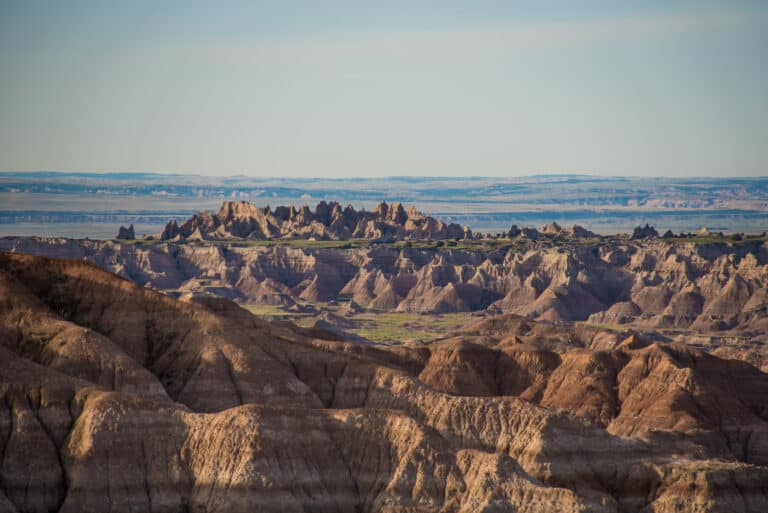
When planning your trip to Badlands National Park, keep the following in mind:
- The park does not allow pets
- Campfires are not permitted
- You are responsible for bringing all your own water
- Follow the principles of Leave No Trace at all times
- Make sure you stay alert to wildlife
Accessibility Information
The colors of the rock formations are breathtaking, and the rugged landscape is simply awe-inspiring.
Accessible boardwalks for wheelchair users include the following:
- Big Badlands Overlook
- Door Trail
- Panorama Point
- Pinnacles Overlook
- Conata Basin Overlook
- Bigfoot Pass Picnic Area
Don’t Miss This Fun Activity: Every night after the ranger program, Cedar Pass Campground Amphitheater hosts a night sky program from Memorial Day to Labor Day. The ranger will explain constellations, stars, and planets so everyone can get a chance to witness some awe-inspiring night sky spectacles. Telescopes provided by Celestron and Badlands Natural History Association are available for everyone.
Places To Stay In The Badlands National Park
You have a few options to spend the night in Badlands National Park. You can rent cabins at Cedar Pass Lodge and Cabins overnight. You can also camp in the park’s two official campgrounds: Cedar Pass and Sage Creek.
Cedar Pass Campground is a paid site with 96 spots available, some of which can accommodate RVs with electrical hookups. Reservations are made by contacting Cedar Pass Lodge online or over the phone at 877-386-4383.
Sage Creek Campground is free and first come, first serve, though vehicles over 18 feet long are prohibited.
If you’re seeking an even more rustic experience, backcountry camping is available anywhere in the park—so long as it is 0.5 miles from trails or roads and not visible from them.
Get more info on popular locations and safety tips on the backcountry camping page here.
Dispersed Campsites
Those with rigs larger than 18 feet looking to camp free close to Badlands National Park can find dispersed campsites on the Forest Service/BLM-managed Buffalo Gap National Grassland.
The area around the park is vast, so if you want to camp on the west side, contact the Fall River Ranger District in Hot Springs, SD, for camping regulations. Contact Wall Ranger District first when camping on the north or east side.
Two great spots near Badlands include the Badlands Boondocking/Overlook Dispersed Camping, which can be found up Highway 240, about three miles from the Pinnacles Entrance. When you get close, you’ll spot a dirt road leading to three radio towers from Highway 240. There’s also plenty of intel online about this particular area at this site.
Scenic Overlooks And Short Hikes Along The Badlands Loop Road
Driving the 39-mile loop of South Dakota Highway 240 between Cactus Flat and Wall without stopping is about an hour drive, but it is uncommon for anyone to do so given that there is so much to see and do here.
Listed below, you will find my favorite Overlooks for sunrise and sunset photos. There are others to check out along the loop road: Big Foot Pass, Prairie Wind, Burns Basin, Homestead, Ancient Hunters, Hay Butte, and Badlands Wilderness.
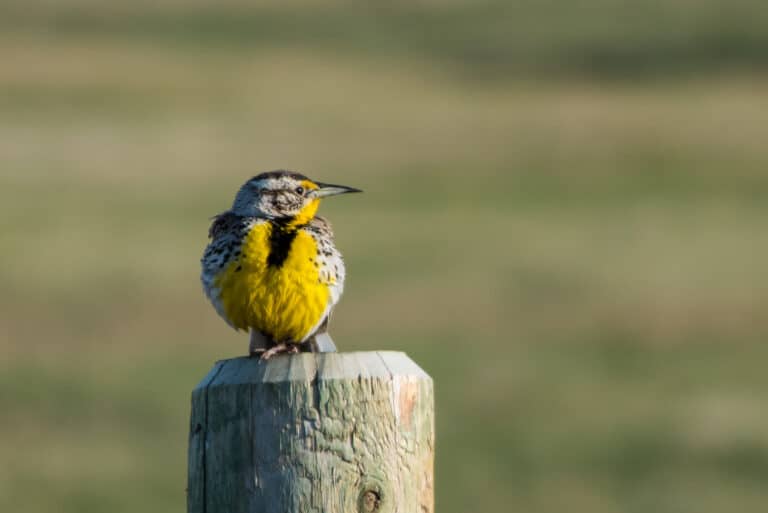
Big Badlands Overlook
The Badlands loop road passes by the Big Badlands Overlook, the first (or last) chance at a scenic stop before the park entrance. You will find a 0.2-mile out-and-back trail to the Overlook just inside the Northeast entrance.
The average completion time is 4 minutes, making it a relatively easy route. There is a lot of foot traffic along this trail, but you can find solitude in the early morning or evening. This is a beautiful overlook for viewing the sunrise.
White River Valley Overlook
The White River Valley Overlook provides impressive vistas of the exceptional badlands landscape. To reach the Overlook, take a seven-mile drive west from the Ben Reifel Visitor Center along the Badlands Loop Road.
Located on the south side of the road, this Overlook offers plenty of parking for RVs and cars with campers. It doesn’t have restrooms or other services, but it is accessible for those in wheelchairs.
The hills around here are marked with vibrant red stripes. A tower-like structure, known as the castle, stands to the east. Beyond the rugged terrain lies a barren prairie landscape in the south.
Fun Fact: Located around six miles south of the Overlook, the White River is a principal tributary of the Missouri River.
Panorama Point Overlook
Panorama Point is one of the best overlooks and views of the Badlands in the park. If you love a gorgeous sunrise, this Overlook is a must-go.
As part of the North Unit of Badlands National Park, the Badlands Wall (formerly Badlands National Monument) is the main feature here. The rock wall looks like something you might find in a futuristic movie from Mars, as it separates the Lower and Upper prairie.
At Panorama Point Overlook, you can see the prairie in the distance as you stand at the top of the jagged spires. Photographs don’t do the landscape justice since seeing their depth can be difficult!
Pinnacles Overlook And Conata Basin Overlook
Pinnacles Overlook and Conata Basin Overlook have the best sunset views for sure!
The walk to Pinnacles Overlook is a 0.4-mile round trip. Usually considered easy and takes about 10 minutes to complete, it’s an extremely popular out-and-back trail.
A straight 500-foot-long boardwalk leads you out to the Conata Basin Overlook. I highly recommend stopping here.
Yellow Mounds Overlook
Right in the middle of the Badlands lies the Yellow Mounds. Millions of years of geological processes have formed stunning layers of yellow, purple, gray, and reddish rocks that have become a favored destination for photographers.
While hikers can explore the vibrant hills independently, the most breathtaking view can be experienced from the Yellow Mounds Overlook around the Golden Hours of the day.
Remember to have your cameras ready because it’s common to spot bighorn sheep along the roadside while driving to the Overlook.
Sage Creek Basin Overlook
The Sage Creek Basin Overlook offers an observation point for a stunningly untouched mixed grass prairie. The erosion of the Badlands formations has left behind soil more suitable for grassland growth and trails spread throughout the area – though these are not maintained by the park. In fact, these trails were made by bison.
And speaking of bison, be sure you drive Rim Road. You may discover a herd of these magnificent animals grazing in the distance.
Their massive frames and shaggy coats are a testament to their resilience in this unforgiving landscape. You can’t help but feel a sense of awe and respect for these creatures as they peacefully go about their day.
Hiking Trails At The Badlands
The Badlands National Park also offers longer hiking treks that could include overnights in the backcountry. A few favorites are:
Castle Trail
Hike the Castle Trail (go west for a sunrise view and east for a sunset panorama) to experience the shifting hues of the north side of Badlands Wall.
This 10.3-mile out-and-back trail is the longest in the park and is rated as moderately difficult, and you can plan on taking around three hours to complete.
April through October offer the best times to explore. And if you’re looking for an immersive experience in nature, this is the trail for you.

Door Trail
The approximate length of the trek is 0.75 miles, round trip. It’s an easy walk, with a wheelchair-accessible boardwalk leading through what is known as “the Door” in the Badlands Wall and ending at a viewpoint of the Badlands. Beyond this point, the maintained trail ends, so all further travel must be undertaken at your own risk – watch out for sudden drop-offs!
The platform is where you can admire the stunning scenery of steep eroded canyons beyond that point. Come at sunrise and bring your camera for a full-on color explosion.
Fossil Exhibit Trail
This easy quarter-mile out-and-back trail is one of the most popular spots for birdwatchers and walkers. It’s located along the Badlands Loop Road and closer to the Interior entrance.
The trail provides many interpretive signs showing information about some of these extinct creatures. You’ll learn more about animals, reptiles, and mammals that lived in this area 67 million years ago (or even more!). No dinosaurs were around, but the land was covered by a shallow sea full of life.
The best time to enjoy the Fossil Exhibit Trail is April through October – and remember, it’s ok to touch the replica tactile exhibits!
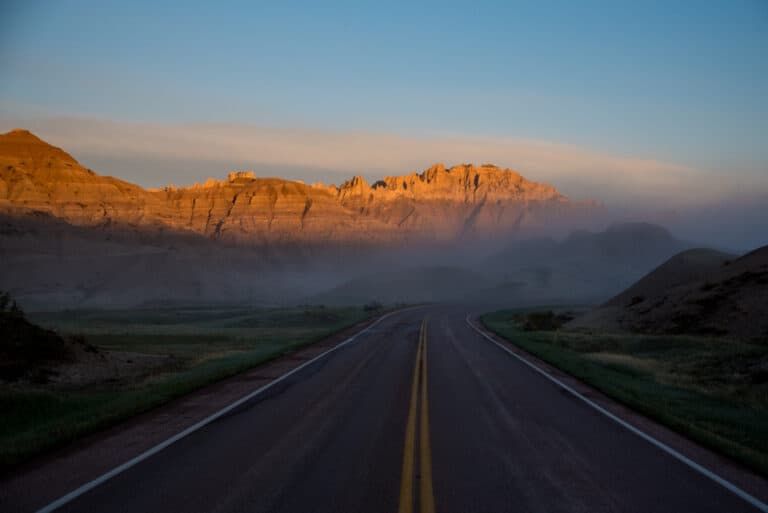
Cliff Shelf Nature Trail
Cliff Shelf is a moderate half-mile loop trail that follows boardwalks and climbs 200 feet in elevation.
This path passes through juniper trees that provide shade, with an occasional pond nearby that attracts wildlife. The boardwalks and stairs make it climb up around 200 feet in elevation. A beautiful morning hike in Badlands National Park could offer wildlife viewing. Before the crowds arrive, get there early to spot Bighorn Sheep, Rattlesnakes, Deer, Quail, Bison, Porcupines, and Bobcats.
This trail has been designed so travelers get breathtaking views of the wild without disrupting it.
Things To Do Near The Badlands
There is so much to do in this part of South Dakota. When planning your trip to The Badlands National Park, consider stopping at some other nearby attractions.
The South Unit is located within the Pine Ridge Indian Reservation and was designated in 1889. then, in 1942, the War Department took 341,725 acres from the Pine Ridge Indian Reservation to establish the Aerial Gunnery Range (Bombing Range) for training during World War II.
Minuteman Missile National Historic Site
The Minuteman Missile is well-known as part of the US’s atomic arsenal, containing enough destructive force to wipe out civilization but placed as a deterrent to keep the peace and avoid warfare.
This missile station touts worldwide delivery of missiles in thirty minutes or less. The Great Plains were home to an extensive nuclear inventory for three decades. A thousand missiles lay in wait, ready to launch immediately, though just a few hundred remain today.
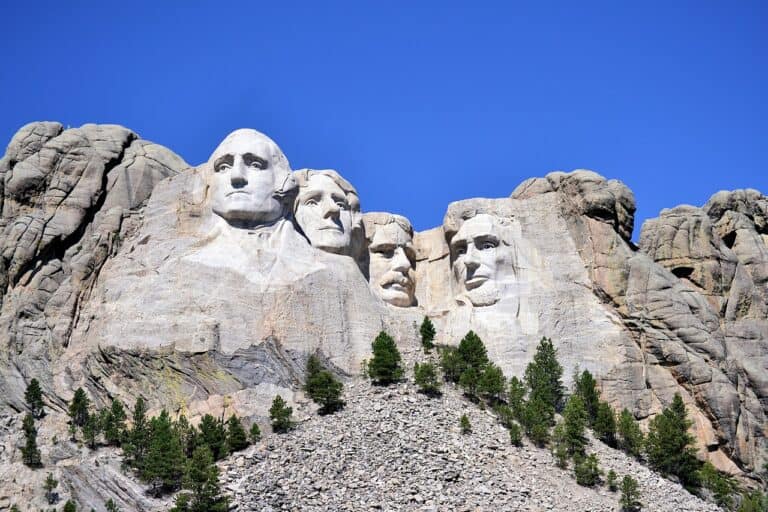
Theodore Roosevelt National Park
Spanning over a vast area in western North Dakota, Theodore Roosevelt National Park is where the Great Plains meets the Badlands. Here, bison, elk and prairie dogs coexist within this protected space. The park is known for its South Unit’s Painted Canyon with its vibrant colors and for the Maltese Cross Cabin, which was once Roosevelt’s home. Moreover, visitors can take the Scenic Loop Drive to explore multiple overlooks and trails.
Mount Rushmore National Memorial is among the most notable sculptures in the Black Hills of South Dakota. Finished in 1941 by Gutzon Borglum and his son Lincoln, the enormous granite images of presidents George Washington, Thomas Jefferson, Theodore Roosevelt, and Abraham Lincoln rise some 60 feet from the mountainside. The area also has a museum with interactive displays.
>>Read this related post: Interesting Stories Behind Five National Monumnet
The Black Hills
A mountain range covering 1.2 million acres of land, stretching 110 miles long and 70 miles wide, the Black Hills of western South Dakota and northeastern Wyoming are known for their beautiful pine-covered hills that seem to go on forever. Their name originates from the Lakota phrase “Paha Sapa,” meaning “hills that are black.”
Millions flock to this region yearly to explore its rich cultural history and landscapes. Learn more here.
From the tall granite peaks to the rolling prairies, Custer State Park is ready to be explored. Its crystal clear mountain streams are inviting, and its wide open spaces are begging to be seen. Take part in all this natural wonder: camping, trekking, biking, swimming, fishing, or just relaxing. 71,000 acres in the Black Hills make up this wonderful park where wildlife abounds, and adventure awaits.
Deep in the western part of South Dakota is Wall Drug, an iconic destination with a storied past. Starting as a small drugstore in 1931, it has since developed into a bustling oasis.
At Wall Drug, you can find meals to satisfy your hunger, gifts and souvenirs to take home as reminders, visitor information for those who want to explore more of the area, and free ice water for all customers–as promised back when the business began.
What started as a struggling store has flourished into a major tourist attraction today, drawing over two million people annually to this small town in South Dakota. Don’t worry about missing the turn to Wall Drug because you will find signs directing you to this store for a hundred miles in either direction on Interstate 90.
Wind Cave National Park is a safe haven for two distinctive landscapes. On the surface, you’ll find bison, elk, and other wildlife roaming grasslands and lush hills. But beneath lies Wind Cave, one of the world’s most comprehensive and perplexing cave systems. It’s been safeguarded as one of America’s oldest national parks.
If you’re in the South Park Unit, visit the White River Visitor Center. There, you can get maps, observe museum displays, and talk with park rangers about the importance of the Badlands and treaties to Lakota culture.
Look up. Look down. Look around!
I hope this article has provided you with helpful information. America’s countryside is brimming with amazing places, aromas, and sounds just waiting to be discovered.
Hiking is an unbeatable way to explore a national park or any other place in the US. So gear up, put a smile on your face and start experiencing.
And remember – bring your camera!!
Cheers to your next adventure!
Hi, I’m Kirsti and I want to help you find new places to explore.
My blog, Kirsti Out Wandering, is a guide for unique experiences. I explore less popular areas to uncover a destination’s culture and hidden potential.
From the perspective of a curious wanderer and photographer, I seek the potential rather than the obvious.
I hope you will wander along with me!



Loved your article!! And your oics!!
Thank you Gary!! 😉